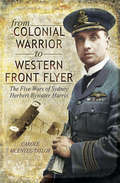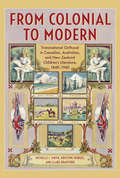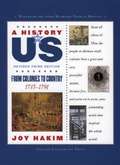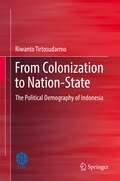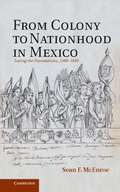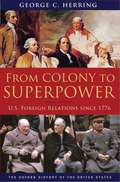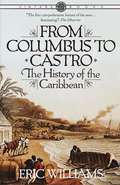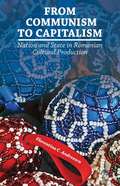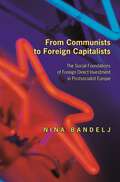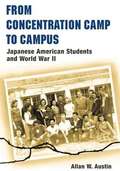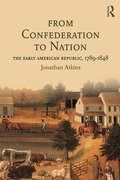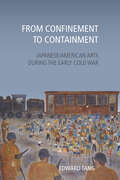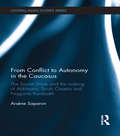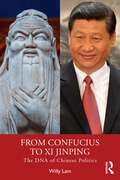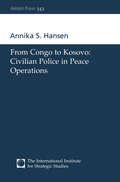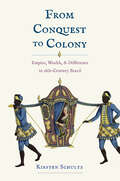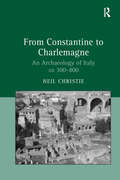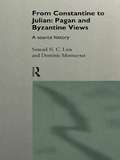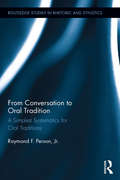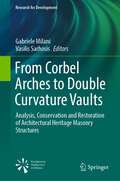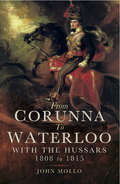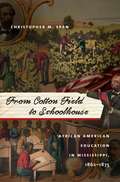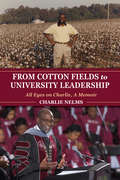- Table View
- List View
From Colonial Warrior to Western Front Flyer: The Five Wars of Sydney Herbert Bywater Harris
by Carole McEntee-TaylorSydney Herbert Bywater Harris was an adventurer, a man possessed of great courage and charm, who fulfilled every schoolboy fantasy and really did 'live the dream'. The second youngest of seven children, the ordinary life held little appeal for Sydney so, in 1898, at the age of 17, he left home in Ilford for the Klondike gold rush. Arriving too late to make his fortune he decided to join the US Army.Two and a half years later, after seeing action in the Boxer Rebellion and the Philippines Insurrection, Sydney returned to England where he met and married Elsa de Verde Verder, a lady from an affluent Vermont family. A year later Sydney joined the Kings Colonials Imperial Yeomanry, later renamed the King Edward's Horse. Still seeking excitement, in August 1914 he transferred to the Royal Flying Corps and in 1916 went to France with 23 Squadron to fly the FE2b. Life expectancy for pilots on the front lines was very short and he was badly wounded while gun-spotting over enemy lines. After several months recovering he was posted to Turnberry as Chief Instructor and on the 13th August 1917, he was posted to Marske (by-the-Sea), with the rank of Lieutenant Colonel, to form and command No.2 Fighting School. In 1919 he was awarded the Air Force Cross.But war was not quite finished with Sydney. In 1936, fleeing imminent bankruptcy, he became involved with the International Brigades in the Spanish Civil War. Returning back to England he joined the RAFVR (Royal Air Force Volunteer Reserve) and when the Second World War broke out he was posted to Turnhouse as Section Controller. This really didn't suit him and, determined to see more action, at the age of 58, he arranged a transfer to France as Adjutant with No 1 Squadron where his duties included liaising with the French Air Force. He later transferred to 1 ATS near Perpignan and was one of the last to leave France with the German Blitzkrieg only a few hours away. Despite his ill health he continued to serve throughout the war and in 1947 became Commander at Marchwood Park where the members of the 'Guinea Pig' club went to recover.A remarkable life led in an era of endless possibilities.Royalties from this book will go to Help 4 Homeless Veterans who support Servicemen and women into suitable accommodation, and empower them to develop a civilian career through their links with employers and other organisations.
From Colonial to Modern: Transnational Girlhood in Canadian, Australian, and New Zealand Literature, 1840-1940
by Kristine Moruzi Michelle J. Smith Clare BradfordThrough a comparison of Canadian, Australian, and New Zealand texts published between 1840 and 1940, From Colonial to Modern develops a new history of colonial girlhoods revealing how girlhood in each of these emerging nations reflects a unique political, social, and cultural context. Print culture was central to the definition, and redefinition, of colonial girlhood during this period of rapid change. Models of girlhood are shared between settler colonies and contain many similar attitudes towards family, the natural world, education, employment, modernity, and race, yet, as the authors argue, these texts also reveal different attitudes that emerged out of distinct colonial experiences. Unlike the imperial model representing the British ideal, the transnational girl is an adaptation of British imperial femininity and holds, for example, a unique perception of Indigenous culture and imperialism. Drawing on fiction, girls’ magazines, and school magazine, the authors shine a light on neglected corners of the literary histories of these three nations and strengthen our knowledge of femininity in white settler colonies.
From Colonies to Country (A History of US #3)
by Joy HakimHow did compliant colonials with strong ties to Europe get the notion to become an independent nation? Perhaps the seeds of liberty were planted in the 1735 historic courtroom battle for the freedom of the press. Or maybe the French and Indian War did it, when colonists were called "Americans" for the first time by the English, and the great English army proved itself not so formidable after all. But for sure when King George III started levying some heavy handed taxes on the colonies, the break from the motherland was imminent. With such enthralling characters as George Washington, Sam Adams, Patrick Henry, Eliza Pinckney, and Alexander Hamilton throughout, From Colonies to Country is an amazing story of a nation making transformation. [This text is listed as an example that meets Common Core Standards in English language arts in grades 4-5 at http://www.corestandards.org.]
From Colonization to Nation-State: The Political Demography of Indonesia
by Riwanto TirtosudarmoThis book examines the history of the political demography of Indonesia. Chronologically, the book begins by introducing the colonization program as a predecessor of transmigration program after independence. The transmigration program, Indonesia’s state policy on migration, is discussed at length in the book but other migration related issues are also presented to show the complex relationship between migration and other social, economic and political issues in Indonesia. In the final chapter, the book discusses the contemporary issues and challenges of disintegration that is facing Indonesia as a nation-state. The book ends with an epilog that shows Indonesia’s political demography challenges in the 21st Century.
From Colony to Nationhood in Mexico
by Sean F. McenroeIn an age of revolution, Mexico's creole leaders held aloft the Virgin of Guadalupe and brandished an Aztec eagle perched upon a European tricolor. Their new constitution proclaimed 'the Mexican nation is forever free and independent'. Yet the genealogy of this new nation is not easy to trace. Colonial Mexico was a patchwork state whose new-world vassals served the crown, extended the empire's frontiers and lived out their civic lives in parallel Spanish and Indian republics. Theirs was a world of complex intercultural alliances, interlocking corporate structures and shared spiritual and temporal ambitions. Sean F. McEnroe describes this history at the greatest and smallest geographical scales, reconsidering what it meant to be an Indian vassal, nobleman, soldier or citizen over three centuries in northeastern Mexico. He argues that the Mexican municipality, state and citizen were not so much the sudden creations of a revolutionary age as the progeny of a mature multiethnic empire.
From Colony to Superpower: U.S. Foreign Relations since 1776
by George C. HerringIn this installment of the multi-volume Oxford History of the United States, Herring delivers a sweeping account of the United States' foreign relations and diplomacy, which tells the dramatic story of America's emergence as superpower--its birth in revolution, its troubled present, and its uncertain future.
From Columbus to Castro: The History of the Caribbean (1492-1969)
by Eric WilliamsFrom Columbus to Castro: The History of the Caribbean is about 30 million people scattered across an arc of islands -- Jamaica, Haiti, Barbados, Antigua, Martinique, Trinidad, among others-separated by the languages and cultures of their colonizers, but joined together, nevertheless, by a common heritage. For whether French, English, Dutch, Spanish, Danish, or-latterly-American, the nationality of their masters has made only a notional difference to the peoples of the Caribbean. The history of the Caribbean is dominated by the history of sugar, which is inseparable from the history of slavery; which was inseparable, until recently, from the systematic degradation of labor in the region. Here, for the first time, is a definitive work about a profoundly important but neglected and misrepresented area of the world.
From Communism to Capitalism
by Florentina C. AndreescuThis book offers an interdisciplinary mode of analyzing transitions from communism and planned economy to democracy and capitalism focusing on how the various social and political transformations are reflected within one hundred Romanian films produced during communism, transition, and post-transition.
From Communists to Foreign Capitalists: The Social Foundations of Foreign Direct Investment in Postsocialist Europe
by Nina BandeljFrom Communists to Foreign Capitalists explores the intersections of two momentous changes in the late twentieth century: the fall of Communism and the rise of globalization. Delving into the economic change that accompanied these shifts in central and Eastern Europe, Nina Bandelj presents a pioneering sociological treatment of the process of foreign direct investment (FDI). She demonstrates how both investors and hosts rely on social networks, institutions, politics, and cultural understandings to make decisions about investment, employing practical rather than rational economic strategies to deal with the true uncertainty that plagues the postsocialist environment. The book explores how eleven postsocialist countries address the very idea of FDI as an integral part of their market transition. The inflows of foreign capital after the collapse of Communism resulted not from the withdrawal of states from the economy, as is commonly expected, but rather from the active involvement of postsocialist states in institutionalizing and legitimizing FDI. Using a wide array of data sources, and combining a macro-level account of national variation in the liberalization to foreign capital with a micro-level account of FDI transactions in the decade following the collapse of Communism in 1989, the book reveals how social forces not only constrain economic transformations but also make them possible. From Communists to Foreign Capitalists is a welcome addition to the growing literature on the social processes that shape economic life.
From Concentration Camp to Campus: Japanese American Students and World War II
by Allan W. AustinIn the aftermath of Japan's attack on Pearl Harbor and the systematic exile and incarceration of thousands of Japanese Americans, the National Japanese American Student Relocation Council was born. Created to facilitate the movement of Japanese American college students from concentration camps to colleges away from the West Coast, this privately organized and funded agency helped more than four thousand incarcerated students pursue higher education at more than six hundred schools during WWII. Allan W. Austin's From Concentration Camp to Campus examines the Council's work and the challenges it faced in an atmosphere of pervasive wartime racism. Austin also reveals the voices of students as they worked to construct their own meaning for wartime experiences under pressure of forced and total assimilation. Austin argues that the resettled students succeeded in reintegrating themselves into the wider American society without sacrificing their connections to community and their Japanese cultural heritage.
From Confederation to Nation: The Early American Republic, 1789-1848
by Jonathan AtkinsIn the era of the Early Republic, Americans determined the meaning of their Revolution and laid the foundation for the United States' later emergence as a world power. This book provides students with an explanation of the major events and developments of one of the most important periods in American History. Focusing on the years between the Revolution and the Civil War, From Confederation to Nation presents a narrative of the era's political history along with discussions of the significant social and cultural changes that occurred across the Union's first six decades. Taking a broad approach which examines economic changes, religious influences, political reform, cultural challenges, and racial and gender inequalities in the Early Republic, Atkins' text is useful for a vast array of critical perspectives. From Confederation to Nation presents an accessible introduction to the Early American Republic that offers readers a solid foundation for more advanced study.
From Confinement to Containment: Japanese/American Arts during the Early Cold War (Asian American History & Cultu)
by Edward TangDuring the early part of the Cold War, Japan emerged as a model ally, and Japanese Americans were seen as a model minority. From Confinement to Containment examines the work of four Japanese and Japanese/American artists and writers during this period: the novelist Hanama Tasaki, the actor Yamaguchi Yoshiko, the painter Henry Sugimoto, and the children’s author Yoshiko Uchida. The backgrounds of the four figures reveal a mixing of nationalities, a borrowing of cultures, and a combination of domestic and overseas interests. Edward Tang shows how the film, art, and literature made by these artists revealed to the American public the linked processes of U.S. actions at home and abroad. Their work played into—but also challenged—the postwar rehabilitated images of Japan and Japanese Americans as it focused on the history of transpacific relations such as Japanese immigration to the United States, the Asia-Pacific War, U.S. and Japanese imperialism, and the wartime confinement of Japanese Americans. From Confinement to Containment shows the relationships between larger global forces as well as how the artists and writers responded to them in both critical and compromised ways.
From Conflict to Autonomy in the Caucasus: The Soviet Union and the Making of Abkhazia, South Ossetia and Nagorno Karabakh (Central Asian Studies)
by Arsène SaparovThis book is the first historical work to study the creation of ethnic autonomies in the Caucasus in the 1920s – the transitional period from Russian Empire to Soviet Union. Seventy years later these ethnic autonomies were to become the loci of violent ethno-political conflicts which have consistently been blamed on the policies of the Bolsheviks and Stalin. According to this view, the Soviet leadership deliberately set up ethnic autonomies within the republics, thereby giving Moscow unprecedented leverage against each republic. From Conflict to Autonomy in the Caucasus questions this assumption by examining three case studies: Abkhazia, South Ossetia and Nagorno Karabakh are placed within the larger socio-political context of transformations taking place in this borderland region during the nineteenth and twentieth centuries. It examines demographic, social and economic consequences of the Russian colonization and resulting replacement of traditional societies and identities with modern ones. Based on original Russian language sources and archival materials, the book brings together two periods that are usually studied separately – the period of the Russian Civil War 1917–20 and the early Soviet period – in order to understand the roots of the Bolshevik decision-making policy when granting autonomies. It argues that rather than being the product of blatant political manipulation this was an attempt at conflict resolution. The institution of political autonomy, however, became a powerful tool for national mobilization during the Soviet era. Contributing both to the general understanding of the early Soviet nationality policy and to our understanding of the conflicts that have engulfed the Caucasus region since the 1990s, this book will be of interest to scholars of Central Asian studies, Russian/Soviet history, ethnic conflict, security studies and International Relations.
From Confucius to Xi Jinping: The DNA of Chinese Politics
by Willy LamThis book analyzes Chinese politics, particularly the rule of Chinese Communist Party (CCP) leaders from Mao Zedong to Xi Jinping, through an examination of the country’s political ideology.This book succinctly covers the DNA of Chinese politics through the philosophies of sages in China’s first liberalization period during the Warring States epoch, principally those of Confucius, Mencius, Lao Zi, Zhuang Zi, Shang Yang and Han Fei. With an appreciation of these traditional ideologies, this book displays how Chinese political philosophy (which incorporates elements of Confucianist and especially Legalist thinking) has influenced ideas and policies from as early as the Qin and Han dynasties through to the Qing dynasty and even to the current day. Highlighting the controversies revolving around the flowering and contention of beliefs and isms during China’s second liberalization in the Republican Period (1912-1949), this book reveals how and why this led to the repression of the CCP era under dictators ranging from Mao Zedong to Xi Jinping.Revealing how Chinese political and philosophical legacies impact the development of ideology and policies of CCP leadership, this book will be a valuable resource to students and scholars of Chinese politics, Chinese history, and international relations.
From Congo to Kosovo: Civilian Police in Peace Operations (Adelphi series #343)
by Annika S HansenAn examination of the role of civilian police in peace operations, which has expanded greatly since the early 1990s and has culminated in international policemen assuming responsibility for law and order in Kosovo and East Timor. It looks at the way civilian police play a critical role in reforming local police forces and at times enforcing the law themselves.
From Congregation Town to Industrial City: Culture and Social Change in a Southern Community (The American Social Experience #3)
by Michael ShirleyIn 1835, Winston and Salem was a well-ordered, bucolic, and attractive North Carolina town. A visitor could walk up Main Street from the village square and get a sense of the quiet Moravian community that had settled here. Yet, over the next half-century, this idyllic village was to experience dramatic changes. The Industrial Revolution calls forth images of great factories, mills, and machinery; yet, the character of the Industrial Revolution went beyond mere changes in modes of production. It meant the radical transformation of economic, social, and political institutions, and the emergence of a new mindset that brought about new ways of thinking and acting. Here is the illuminating story of Winston-Salem, a community of artisans and small farmers united, as members of a religious congregation, by a single vision of life. Transformed in just a few decades from an agricultural region into the home of the smokestacks and office towers of the R.J. Reynolds Tobacco Company and the Wachovia Bank and Trust Company, the Moravian community at Salem offers an illuminating illustration of the changes that swept Southern society in the nineteenth century and the concomitant development in these communities of a new ethos. Providing a rich wealth of information about the Winston-Salem community specifically, From Congregation Town to Industrial City also significantly broadens our understanding of how wholesale changes in the nineteenth century South redefined the meaning and experience of community. For, by the end of the century, community had gained an entirely new meaning, namely as a forum in which competing individuals pursued private opportunities and interests.
From Conquest to Colony: Empire, Wealth, and Difference in Eighteenth-Century Brazil
by Kirsten SchultzA new history of Brazil&’s eighteenth century that foregrounds debates about wealth, difference, and governance Transformations in Portugal and Brazil followed the discovery of gold in Brazil&’s hinterland and the hinterland&’s subsequent settlement. Although earlier conquests and evangelizations had incorporated new lands and peoples into the monarchy, royal officials now argued that the extraction of gold and the imperatives of rivalry and commerce demanded new approaches to governance to ensure that Brazil&’s wealth flowed to Portugal and into imperial networks of exchange. Using archival records of royal and local administrations, as well as contemporary print culture, Kirsten Schultz shows how the eighteenth-century Portuguese crown came to define and defend Brazil as a &“colony&” that would reinvigorate Portuguese power. Making Brazil a colony entailed reckoning with dynamic societies that encompassed Indigenous peoples, Africans, and Europeans; the free and the enslaved; the wealthy and the poor. It also involved regulating social relations defined by legal status, ancestry, labor, and wealth to ensure that Portuguese America complemented and supported, rather than reproduced, metropolitan ways of producing and consuming wealth.
From Constantine to Charlemagne: An Archaeology of Italy AD 300–800
by Neil ChristieThis book offers an overview of the archaeological and structural evidence for one of the most vital periods of Italian history, spanning the late Roman and early medieval periods. The chronological scope covers the adoption of Christianity and the emergence of Rome as the seat of Western Christendom, the break-up of the Roman west in the face of internal decay and the settlement of non-Romans and Germanic groups, the impact of Germanic and Byzantine rule on Italy until the rise of Charlemagne and of a Papal State in the later eighth century. Presenting a detailed review and analysis of recent discoveries by archaeologists, historians, art historians, numismatists and architectural historians, Neil Christie identifies the changes brought about by the Church in town and country, the level of change within Italy under Rome before and after occupation by Ostrogoths, Byzantines and Lombards, and reviews wider changes in urbanism, rural exploitation and defence. The emphasis is on human settlement on its varied levels - town, country, fort, refuge - and the assessment of how these evolved and the changes that impacted on them. Too long neglected as a 'Dark Age', this book helps to further illuminate this fascinating and dynamic period of European history.
From Constantine to Julian: A Source History
by Dominic Montserrat Samuel N. C. LieuFrom Constantine to Julian provides students with important source material, covering an age of major transition in Europe; an age which saw the establishment of Rome as a Christian Empire and a period of recidivism under Julian.Texts included are the anonymous Origo Constantini^; Eumenius, Panegyric of 310; Byzantine life of Constantine; Libanius, oration 59; and the Passion of Artemius. Most of this material has not previously been translated into English: students will now have direct access to the most important sources for the period which is studied on courses in classical antiquity, early medieval Europe and ecclesiastical history.
From Conversation to Oral Tradition: A Simplest Systematics for Oral Traditions (Routledge Studies in Rhetoric and Stylistics #10)
by Raymond F PersonThis book argues that many of the most prominent features of oral epic poetry in a number of traditions can best be understood as adaptations or stylizations of conversational language use, and advances the claim that if we can understand how conversation is structured, it will aid our understanding of oral traditions. In this study that carefully compares the "special grammar" of oral traditions to the "grammar" of everyday conversation as understood in the field of conversation analysis, Raymond Person demonstrates that traditional phraseology, including formulaic language, is an adaptation of practices in turn construction in conversation, such as sound-selection of words and prosody, and that thematic structures are adaptations of sequence organization in talk-in-interaction. From this he concludes that the "special grammar" of oral traditions can be understood as an example of institutional talk that exaggerates certain conversational practices for aesthetic purposes and that draws from cognitive resources found in everyday conversation. Person's research will be of interest to conversation analysts as well as literary scholars, especially those interested in ancient and medieval literature, the comparative study of oral traditions and folklore, and linguistic approaches to literature. This volume lays the groundwork for further interdisciplinary work bridging the fields of literature and linguistics.
From Corbel Arches to Double Curvature Vaults: Analysis, Conservation and Restoration of Architectural Heritage Masonry Structures (Research for Development)
by Gabriele Milani Vasilis SarhosisThe book focuses on all typological aspects of arches and vaults within the heritage of design and construction, while bringing attention to new “green” materials, promoting a circular economy informed by limitations caused by global warming. The multidisciplinary approach involves several different competences in architecture, structural engineering, conservation and restoration, geomatics, BIM, building engineering, the technology and history of construction, graphical methods of assessment, and innovative design that utilizes non-polluting materials. After an overview of the technical and aesthetic advantages of masonry vaults, there is a review of the most up-to-date trends in historic preservation. Classic methods of static assessment and innovative building technologies are detailed. Surveying methods and data acquisition are discussed, particularly laser scanning technology and its applications in heritage masonry curved structures. Next comes the experimental static and dymanic behavior of masonry vaults, followed by a critical revision of Distinct Element innovative computerized Methods. An explanation as to how to pass from classic stability analysis to an adaptive Finite Element Method limit analysis procedure is offered. Reinterpretation of the past is then undertaken, with an eye towards emphasizing sustainability. Finally, the conclusion examines still existing gaps in knowledge and recommends avenues of future research.
From Cork to Calcutta::My Mother's Story
by Milty BoseImelda Connor is a classic Irish lass-a fiery, red-headed beauty, quick to anger, and fiercely protective of her younger siblings. Growing up on a small farm in the rolling hills of County Cork, she thinks she has her life completely mapped out. But Imelda soon finds that life doesn't always go according to plan. Everything is turned upside-down when Imelda moves to England and happens to meet a dashing Bengali man named Shu Bose. Shu is captivated by Imelda's natural beauty and charm, and the two embark on a whirlwind romance. At the age of eighteen, in the spring of 1932, Imelda boards a ship bound for Calcutta-and a very different life to the one she had always imagined. Milty Bose's writing transports readers back to pre-Independence India, to London between the wars, and to the genteel life of bhadralok Bengali high society. From Cokr to Calcutta tells the true story of Bose's parents, their eccentric and unforgettable family, the trauma of loss, and the triumph of one woman's remarkable spirit.
From Corunna to Waterloo: With The Hussars 1808 To 1815
by John MolloBasing his story on contemporary letters, diaries and reports and a comprehensive bibliography, John Mollo takes the reader into the heart of the Hussar Brigade in peace and war, depicting its many colourful characters with a sure hand and describing every facet of day-to-day life, in barracks and on the battlefield. This is a story based on the harsh realities of war in the early years of the nineteenth century. Written with great elegance, the touch of a natural story teller and the imprint of a true lover and student of military history, this is a book to treasure.
From Cotton Field to Schoolhouse
by Christopher M. SpanIn the years immediately following the Civil War--the formative years for an emerging society of freed African Americans in Mississippi--there was much debate over the general purpose of black schools and who would control them. From Cotton Field to Schoolhouse is the first comprehensive examination of Mississippi's politics and policies of postwar racial education. The primary debate centered on whether schools for African Americans (mostly freedpeople) should seek to develop blacks as citizens, train them to be free but subordinate laborers, or produce some other outcome. African Americans envisioned schools established by and for themselves as a primary means of achieving independence, equality, political empowerment, and some degree of social and economic mobility--in essence, full citizenship. Most northerners assisting freedpeople regarded such expectations as unrealistic and expected African Americans to labor under contract for those who had previously enslaved them and their families. Meanwhile, many white Mississippians objected to any educational opportunities for the former slaves. Christopher Span finds that newly freed slaves made heroic efforts to participate in their own education, but too often the schooling was used to control and redirect the aspirations of the newly freed.
From Cotton Fields to University Leadership: All Eyes on Charlie, A Memoir
by Charlie NelmsThe renowned leader in higher education provides “a testament to the power of aspiration, character and education to overcome poverty and adversity” (Michael L. Lomax, President & CEO, United Negro College Fund).Charlie Nelms had audaciously big dreams. Growing up black in the Deep South in the 1950s and 1960s, working in cotton fields, and living in poverty, Nelms dared to dream that he could do more with his life than work for white plantation owners sun-up to sun-down. Inspired by his parents, who first dared to dream that they could own their own land and have the right to vote, Nelms chose education as his weapon of choice for fighting racism and inequality.With hard work, determination, and the critical assistance of mentors who counseled him along the way, he found his way from the cotton fields of Arkansas to university leadership roles. Becoming the youngest and the first African American chancellor of a predominately white institution in Indiana, he faced tectonic changes in higher education during those ensuing decades of globalization, growing economic disparity, and political divisiveness. From Cotton Fields to University Leadership is an uplifting story about the power of education, the impact of community and mentorship, and the importance of dreaming big.“In his memoir, the realities of his life take on the qualities of a good docudrama, providing the back story to the development of a remarkable educational leader. His is ‘the examined life,’ filled with honesty, humor, and humility. While this is uniquely Charlie’s story, it is a story that will lift the hearts of many and inspire future generations of leaders.” —Betty J. Overton, Director, National Forum on Higher Education for the Public Good
